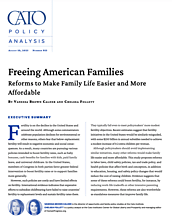However, such policies are costly and have limited effects on fertility. International evidence indicates that expensive efforts to subsidize childbearing have failed to raise countries’ fertility to replacement levels and sustain fertility rates there. They typically fail even to meet policymakers’ more modest fertility objectives. Recent estimates suggest that fertility initiatives in the United States would be similarly misguided, with some $250 billion in annual subsidies needed to achieve a modest increase of 0.2 extra children per woman.
Although policymakers should avoid implementing similar initiatives, many other reforms would make family life easier and more affordable. This study proposes reforms to labor laws, child safety policies, tax and trade policy, and health policies that affect birth and conception, in addition to education, housing, and safety policy changes that would reduce the cost of raising children. Evidence suggests that some of these reforms could boost fertility, for instance, by reducing work‐life tradeoffs or other intensive parenting requirements. However, these reforms are also worthwhile as standalone measures that improve family life.




